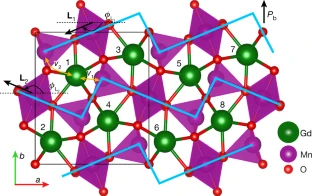Phys.org July 6, 2022
Electric control of magnetism and magnetic control of ferroelectricity can improve the energy efficiency of magnetic memory and data-processing devices. However, the necessary magnetoelectric switching is hard to achieve, and requires more than just a coupling between the spin and the charge degrees of freedom. An international team of researchers (Italy, Austria, USA – Rutgers University, the Netherlands) showed that an application and subsequent removal of a magnetic field reverses the electric polarization of the multiferroic GdMn2O5, thus required two cycles to bring the system back to the original configuration. During this unusual hysteresis loop, four states with different magnetic configurations are visited by the system, with one half of all spins undergoing unidirectional full-circle rotation in increments of about 90 degrees. Therefore, GdMn2O5 acts as a magnetic crankshaft that converts the back-and-forth variations of the magnetic field into a circular spin motion. This peculiar four-state magnetoelectric switching emerges as a topologically protected boundary between different two-state switching regimes. According to the researchers their findings establishes a paradigm of topologically protected switching phenomena in ferroic materials… read more. TECHNICAL ARTICLE

Magnetic unit cell of GdMn2O5. Credit: Nature volume 607, pages81–85 (2022)